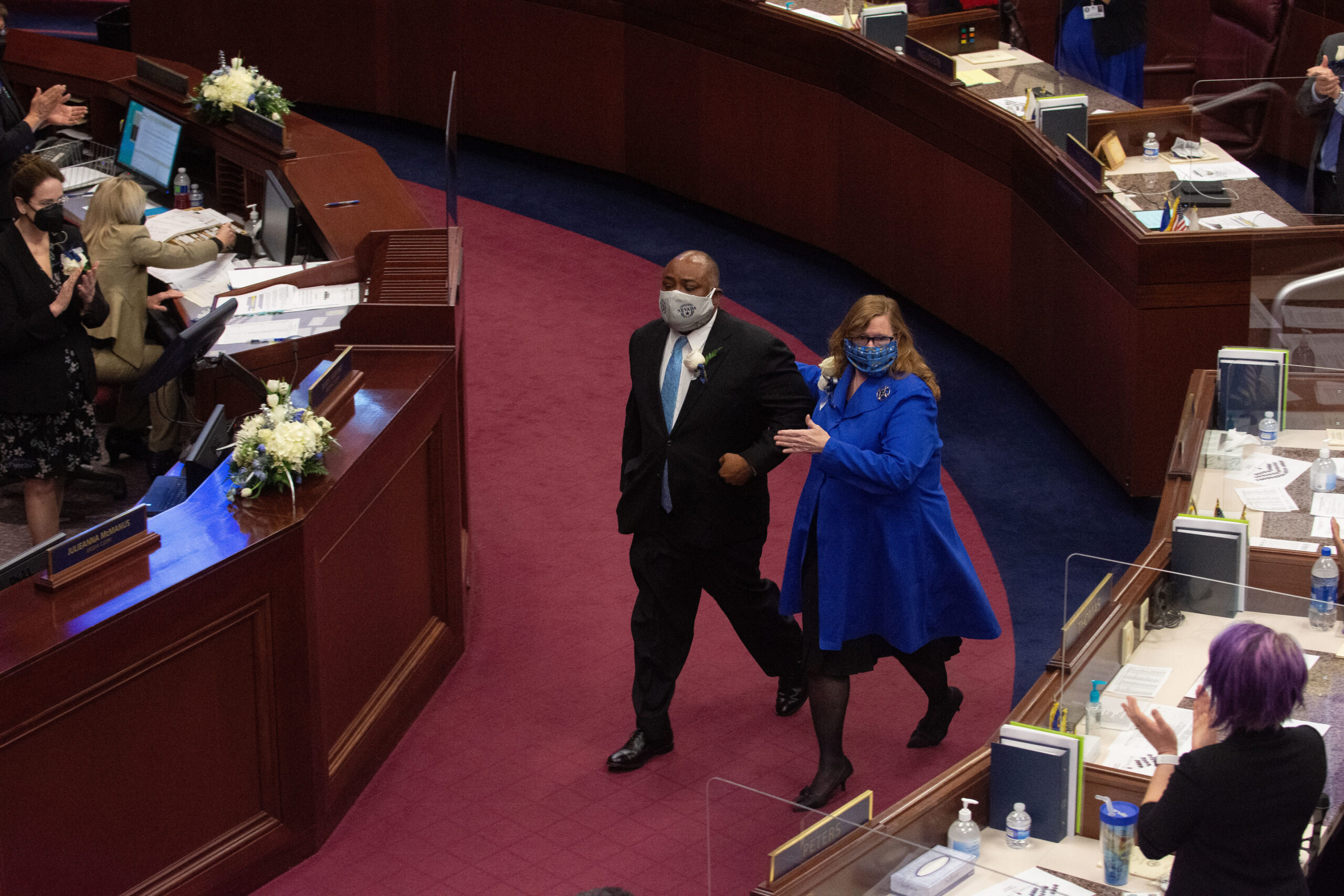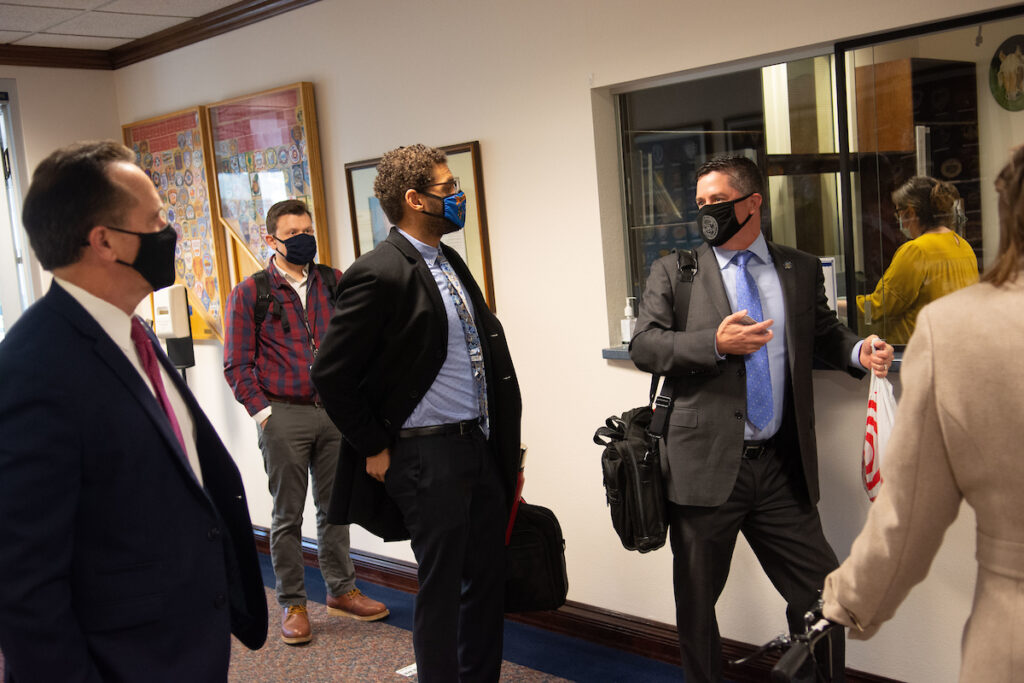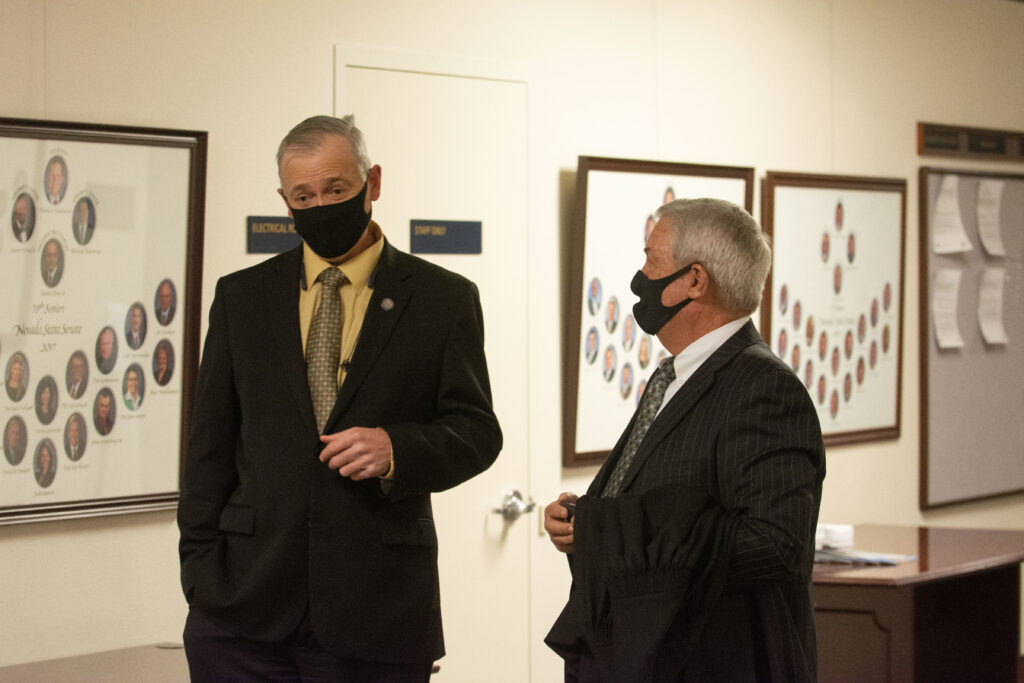Behind the Bar: Big plans, less funding for state grants office, police changes after summer Black Lives Matter protests and Sisolak Promise Tracker update

Behind the Bar is The Nevada Independent’s newsletter devoted to comprehensive and accessible coverage of the 2021 Legislature.
In this edition: major updates from state grants office initiatives, criminal justice updates, how Vegas police have changed policies after Black Lives Matter protests this summer, a Sisolak Promise Tracker update and some noteworthy numbers from the higher education system.
Check this link to manage your newsletter subscriptions. The newsletter is published on Mondays and Thursdays.
I want to hear from you! Questions, comments, observations, jokes, what you think we should be covering or paying attention to. Email me at [email protected].
Gov. Steve Sisolak is running for re-election.
There hasn’t yet been a big formal launch for the Democratic governor’s re-election campaign (he confirmed re-election plans last year), but signs are starting to creep in — increased activity of a governor-aligned political action committee (Home Means Nevada PAC), going on publicized tours of facilities and buildings and generally touting a relatively apolitical agenda focused on economic development during the 2021 Legislature.
The commingling of Sisolak’s legislative agenda focused on efforts to help the state recover from the COVID-19 pandemic and political concerns with the upcoming re-election campaign are readily apparent in the quick processing of AB106 on Wednesday evening.
In a vacuum, the bill makes sense. It’s an extra $50 million to the Pandemic Emergency Technical Support grant program, which provides grants between $10,000 and $20,000 to small businesses, nonprofits and other applicable groups.
The program initially received $51 million in federal coronavirus relief funds — AB106 adds another $50 million in state dollars to the program, which will be directed to unfulfilled applications submitted last year (more than 13,500 applications for the program were submitted last October, or about 10 times the initial funding available).
Pushing the bill through now follows up on Sisolak’s request for the same in the State of the State, and gets needed dollars to businesses as soon as possible (lawmakers could run into trouble with the constitutional requirement to fund K-12 education first if they delay program implementation into the upcoming fiscal year).
But to be clear, there is a political undercurrent to much of this. It’s why the bill is coming up during the second week of session, why Sisolak himself gave opening remarks and why a cadre of high-profile business leaders (including the Las Vegas Metro Chamber) all testified in favor of the measure.
It’s a safe bet that this bill will pass with bipartisan support, and probably make it to the governor’s office sometime next week (assuming lawmakers don’t fast-track the measure). I’d also expect Sisolak’s office and the governor himself to trumpet the additional program funding once the bill is signed. It also wouldn’t be surprising to see funding end up in re-election material down the road, either.
The marriage of Sisolak’s legislative agenda with political priorities will be a trend to watch over the remaining 110 days (ugh) of the session — how and if there are any divergences between plans to improve the state’s economy and what legislative “wins” the governor wants to run on in what’s likely to be a tough 2022 campaign.
— Riley Snyder

Funding axed for long-delayed grants management software project
It’s estimated that Nevada likely loses millions of dollars in potential federal grants every year because of the lack of a statewide grants management system.
But despite a promise by Gov. Steve Sisolak in his 2021 State of the State address to greatly increase the number of federal grants coming into the state, the state grants office is preparing to enter the next budget cycle without funding for a dedicated grants management system — an absence that a former grants advisory council chair said, “(delays) Nevada getting hundreds of millions of dollars a year in additional federal funding.”
During a presentation Tuesday before the Assembly Government Affairs Committee, interim grants office Administrator Erin Hasty said that the office’s long-held but oft-delayed plans to implement a grants management software program were essentially on ice amid the state’s budget crunch and questionable economic status amid the COVID-19 pandemic.
Lawmakers first allocated funding ($200,000 per year) for implementation of a grants system in the 2017 session — part of a state effort to improve its poor placing in the national ranking of states that bring in the largest shares of federal grant dollars. The recommendation came from a federal grants-focused panel formed in 2015, which found states higher on the national federal grant recipient rankings list tended to have some kind of central software to match grant opportunities with potential applicants (state or local agencies, businesses or nonprofits).
But the program never got off the ground. After the state awarded the contract bid, it was sued by an unsuccessful bidder, which claimed that the former head of the office had tipped the scales in favor of a preferred company. A District Court judge ruled against the state in May 2019, meaning the contract was reopened to potential bidding.
While lawmakers in 2019 again allocated $200,000 per year to the office to fund a contract, the office said that despite filing multiple requests for proposal, no contractors had submitted a bid that would cover everything the office was looking for in such a software system.
“The bottom line is that vendors just could not provide an enterprise system with full functionality for the allotted budget,” the grants office’s website states.
Hasty said Tuesday that the office had instead filed a request for information in February 2020 to get a better sense of what kind of budgetary request they would need going forward to implement such a software system. But that request was pulled in April, given expected “unforeseen budgetary impacts” caused by the pandemic.
“Unfortunately, we had that study lined up and ready to go, but then also due to COVID and the budget shortfalls we reverted that back as well,” she said.
Instead, the office will for the foreseeable future continue plugging along on its current system, previously described by the agency as the “ad hoc and complex” web of Excel spreadsheets currently in use by the agency to manage and oversee grants. The office’s website says the state will pursue funding for a grants management system once the state is “again on solid economic and budgetary footing.”
Sisolak — whose proposed budget otherwise keeps funding flat for the grants office over the two-year budget cycle — in his State of the State address called for the state to increase its share of federal grants by $100 million over the next two years and by $500 million annually by 2026.
— Riley Snyder
Matching grants pilot project a success, but no additional funding expected
The state grants office had a promising response to a pilot program approved in the 2019 Legislature, where the state allocated $1 million to be used for grants that require a state matching fund — a program aimed at capturing federal dollars otherwise left at the table because the state agency or business couldn’t put forward necessary matching funds.
Hasty said the office received 31 applications and committed $970,000 of the original million dollars within the first three months of the program (starting in January 2020), but stopped accepting applications in April 2020 under the assumption that remaining funds would be reverted back to the state’s general fund.
So far, only one matching grant — $45,129 to the North Las Vegas Fire Department — has been fully executed, with the fire department receiving a $451,292 grant from the U.S. Dept. of Homeland Security. According to the office, the grants went to “replace 16 aging cardiac monitors to meet current standards and community need.”
Two other allocations of matching grants (worth a combined $925,049) were approved by lawmakers but still haven’t been notified if they’ll receive the corresponding federal grant dollars.
The other two state-approved pending grant applications include:
- A tribal government-backed grant to bring high-speed internet to farms and rural communities; state match of $855,000, with a federal match of $2.6 million.
- A nonprofit organization to provide “human and family services,” with a state match of $70,000 and a federal grant of $210,000.
Under current law, the state share of those grants will revert back if the grants aren’t awarded by June 30 (the end of the fiscal year).
Assuming lawmakers don’t introduce a bill funding the program, it’ll close shop at the end of the fiscal year in July. But the grants office said in its report on the program that the brief experiment has potential for future success.
“With the...pilot program’s successful launch and three months of operation, the Grant Office believes it has showed that the pilot program could be a successful, permanent program if fully resourced and staffed,” the office wrote in the report.
— Riley Snyder
Vegas police discuss lessons learned from 318 protests in 2020
Las Vegas police say they updated policies on protests and civil unrest amid criticism over their handling of the Black Lives Matter protests over the summer.
Chuck Callaway, a lobbyist for the Las Vegas Metropolitan Police Department, told the Assembly Judiciary Committee on Monday that the agency updated its use of force policies and protest protocol in 2020.
Those changes include placing a person in a recovery position when providing medical assistance (which ensures they are able to breathe), prohibiting the use of the lateral vascular neck restraint (LVNR), making crowd dispersal orders clearer and only deploying pepper spray into a crowd if approved by a commander.
Callaway said in his presentation that many of the arrests from the Black Lives Matter protests were made for not following dispersal orders given after police declared the assembly unlawful for no longer being peaceful. The agency found that people couldn’t hear the order or did not know where to go, so it has adapted with a policy to give dispersal orders at multiple locations around the crowd and to provide an exit route for the crowd to follow.
Callaway said that the agency had not expected Las Vegas’ protests to turn violent as they did in other cities. But among the peaceful majority, some attendees threw frozen water bottles, bricks and rocks at officers, leading to 45 officer injuries between May 29 and June 3. Remaining protests and gatherings through July 31 did not have any more injuries recorded.
“There was a mindset that we had been working good with the community and had good community relationships … there are always ways we can improve but I think that we assumed that it wasn't going to happen in Las Vegas,” Callaway said. “But the vast majority of people that attended them were exercising their First Amendment rights and acting peacefully.”
During 2020, LVMPD handled 318 protests. Eventually, the police agency made a greater effort to create a dialogue with protest organizers ahead of time, which Callaway said resulted in more peaceful marches and fewer incidents by “mitigating any bad apples” that might have later joined in with the protesters.
But sometimes protest leaders didn't want to communicate with the police because of lack of trust, Callaway said.
“We learned a lot of lessons over the past year in regards to protests and civil unrest, and so we've created a new policy to help us do a better job,” he said.
Lawmakers have even more proposals intended to curb what critics see as overly aggressive policing during protests. Democratic Sen. Dallas Harris, for example, wants to include in the law restrictions on the use of rubber bullets and rules on giving sufficient warning before releasing pepper spray into a crowd.
— Jannelle Calderon
Eliminating racial bias in criminal justice
Southern Nevada prosecutors publicly acknowledged they believe implicit racial bias exists — a declaration that could ease the passage of bills to curb the effects of unconscious stereotypes in the criminal justice system.
Lawmakers this week introduced SB108, sponsored by the Senate Judiciary Committee, which would require “any person employed in the criminal justice system in this State to complete periodic training relating to implicit bias and cultural competency.” It would also require the attorney general to adopt regulations concerning that training.
The bill was also mentioned briefly in Tuesday’s Assembly Judiciary Committee meeting, when John Jones, chief Clark County deputy district attorney, said that his office does believe in the issue of implicit racial bias. Jones also said that his office has already received training on the issue and on understanding implicit bias.
During the meeting, Assemblywoman Shannon Bilbray-Axelrod (D-Las Vegas) brought up a blind charging system that could help mitigate the effects of implicit racial bias.
The system, created by the Stanford Computational Policy Lab, has been used by the San Francisco District Attorney’s office, and it works by way of redacting race-related information from the case narratives that district attorneys read before making charging decisions on incoming felony cases.
Implicit racial bias was also a hot topic in 2019 when the Legislature passed AB478, which requires police officers to complete annual training on topics including racial profiling, mental health and implicit bias recognition. Assembly Speaker Jason Frierson (D-Las Vegas) previously said that a state board overseeing officer training is not fully implementing the law, but the board’s executive director Mike Sherlock said that the board does ensure that individual agencies are complying with the objectives for each training topic.
— Sean Golonka
By the numbers
Legislators in the Assembly Education Committee heard presentations Tuesday from two top higher education officials: system Chancellor Melody Rose and UNLV Medical School Dean Marc Kahn. Across those two presentations, a handful of numbers stuck out.
24,000: The number of vaccinations administered by UNLV since the first two coronavirus vaccines were approved and shipped out by the federal government late last year. Kahn said his goal, as the vaccination process continues and a third vaccine candidate nears approval, is for UNLV to remain involved “until each and every eligible person in Southern Nevada is vaccinated for this potentially fatal disease.”
8 percent: The decline in enrollment across Nevada community colleges compared to the prior fall. Likely triggered by the continued widespread use of virtual learning in the wake of the COVID pandemic, Rose touted Nevada’s figures as positively robust compared to some other higher education systems that have been “slammed” by double-digit enrollment losses “upwards of 15 to 30 percent.” Rose said NSHE “very much expect[s] those folks to be back” once learning goes back to business-as-usual (a sentiment echoed by community college presidents in my conversations with them over the last week).
2022: More precisely, late-summer or early fall 2022, about the time the new UNLV medical education building should be complete. In some stage of development for nearly half a decade, construction on the building finally began last year as part of a public-private partnership spearheaded by a private development corporation. The project will likely receive one last push from the state this session: a reinstatement of $25 million in once-cut state funding meant to cover what hasn’t been funded by private donors.
56.9 percent: That’s the number of minority students at NSHE institutions (as of fall 2018, the date of the most recent federal data and the data presented to lawmakers). That number has risen steadily over the past decade, so much so that NSHE had become a majority-minority system by 2015.
51,000: Number of community college students across Nevada, of which 57 percent are female and 58 percent are students of color. It’s nearly half of all NSHE students statewide, and it could also be the total number of affected students should lawmakers follow the governor’s lead on a proposed idea to create a new governance structure for the state’s four community colleges.
— Jacob Solis
Sisolak Promise Tracker update
We’ve got an update on one (of the nearly 55) promises listed on our Sisolak Promise Tracker page.
During the 2018 campaign, Sisolak wrote in a Reno Gazette-Journal op-ed that if elected, he would “appoint experienced leaders from the private sector" to serve as economic development "ambassadors" for industries such as renewable energy, technology, manufacturing, logistics, mining and rural economic development.
“Deputy directors will be ambassadors to businesses seeking to locate and expand in Nevada, and they will be the primary liaison between my office and private sector companies in emerging industries,” the future governor wrote in the op-ed.
We’ve had that promise listed as “not addressed” since the 2019 Legislature, as there have been no public announcements regarding creation of any private-sector focused “deputy director” positions within the Governor’s Office of Economic Development (GOED). Prior to the publication of our latest update of the promise tracker feature, we reached out to GOED to see if there had been any traction as it relates to that promise.
GOED got back to us a few days after publication of the update, and in a 284-word statement, made the case that the promise had been fulfilled through the hiring of GOED Director Michael Brown — the former head of Barrick Gold USA.
The office also noted that many of its current employees had private-sector experience, and that Brown’s tenure (which began in October 2019) has been largely focused on responding to the COVID-19 pandemic.
“Just four months after Director Brown started, GOED’s role changed radically in response to the pandemic,” the office said in a statement. “That is hardly enough time to have been able to create and add new deputy director positions. Director Brown is committed to the Governor’s vision of bringing in industry experts and ambassadors into GOED when we get to the other side of this budget crisis.”
We’re keeping this promise as “not addressed” for the time being, however. There’s a difference between what Sisolak called for in that op-ed — bringing on dedicated and specified deputy directors to work with private businesses — and hiring a director of an agency with private sector experience.
— Riley Snyder

What we’re reading
If you missed it on Sunday, be sure to check out Michelle Rindels’ excellent overview of criminal justice issues before the Legislature, including updates on police reform, death penalty repeal, bail and other major issues.
Daniel Rothberg on why a proposal to create new specialty water courts was DOA on the first day of the session.
Jacob Solis digs into the governor’s State of the State proposal to split community colleges off into their own governing body. Lots of really interesting details, and it sounds like the idea surprised many community college leaders.
Our Freshman Orientation series continues with Assemblywoman Venicia Considine and Sen. Fabian Doñate.
Tesla agreed to donate millions of dollars to education in Nevada as part of its massive tax abatement deal with the state in 2014, but questions are lingering as to who gets to decide where those donations go, the Nevada Current’s April Corbin reports.
Nevada’s prison system wants to exclude inmates from the state’s Sexual Assault Survivors’ Bill of Rights (Nevada Current).
Carson City businesses aren’t seeing the normal rush of legislative traffic (Las Vegas Sun).
Similar reporting on slower-than-normal business near the capitol (CarsonNow.org).
Nevada Mining Association President Tyre Gray is not only the first African-American head of the mining industry association, but the first African-American head of any trade association in Nevada (Fox5).
UPCOMING DEADLINES
Days to take action on Initiative Petitions before they go to the 2022 ballot: 30 (March 12, 2021)
Days Until Legislator Bill Introduction Deadline: 33 (March 15, 2021)
Days Until Sine Die: 110 (May 31, 2021)
Updated at 9:28 a.m. on Thursday, February 11, 2021, to correct the spelling of interim Grants Office administrator Erin Hasty's name.



